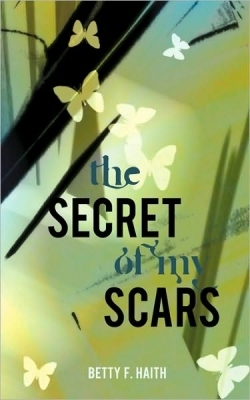The Secret of My Scars
Deep, unsightly scars trace their way up and down Essie Mae’s neck, shoulders, and arms—painful reminders of a tumultuous past she would rather forget. In the summer heat, Nina fans herself out on the porch and studies her grandmother’s scars, curious. They are a mystery, a glimpse into a dark and foggy past at odds with the Jesus-loving woman she’s looked up to since she was a child. When Nina finally asks, “Grandma Essie…how’d you get those scars?” the question triggers a lifetime of stories that both shock and illuminate.
In The Secret of My Scars, Betty F. Haith creates an absorbing multigenerational tome that seeks to teach its readers through the story of devout, born-again Christian, Essie Mae. Employing an interview-style narrative, granddaughter Nina poses probing questions while piece-by-piece, Essie Mae reveals her life story. With glimpses into her grandmother’s partying lifestyle, Nina learns of Essie Mae’s exploits with strings of rough, abusive men, unexpected pregnancies, and her life as an unavailable, alcoholic mother. Nina is both shocked and intrigued, while Essie Mae struggles with her decision to share the seedy bits of her past.
The energy of Essie Mae’s narration is one of the main strengths of this book. Essie Mae’s style of speaking—colloquial expressions and the rhythmic flow of words are kept intact. The reader, like Nina, experiences oral history—a lively voice, unique syntax. The events of her life are told in great visual detail; the young, shapely Essie Mae rising from the pages like an apparition. Essie Mae’s voice and story ring true and keep the reader absorbed from page to page. These events are truly captivating, from “splashing open” worms as a child, to first love and loss. Her struggle to tell her secrets transforms into a spiritual experience, the telling becomes a cleansing act, a gift to others—both characters and readers.
Though her voice is meticulously crafted, Essie Mae’s is not yet a fully-fledged character. Though the reader learns in great detail the events of Essie Mae’s life, they never get a real sense of why Essie Mae is drawn to such a destructive lifestyle—what leads her from man to man? What motivates her party and drinking obsession? There is a lack of emotional depth—what goes on inside a woman’s heart and mind when her children die as a result of her own neglect? There are deep injuries to Essie Mae’s soul, a void she tries to fill, but the reader never finds out what or why. The narrative rarely, if ever, delves deep into Essie Mae’s mind to reveal her innermost motivations. Instead, the reader is given an easy answer—Essie Mae followed the devil and thus, suffered. Later, she was invigorated by the Holy Spirit and led to live a better life. This reasoning is perfectly acceptable, but would be more effective with a deeper, more invested investigation of Essie Mae’s character and flaws. Otherwise, Essie Mae acts as more of a mouthpiece than a living, injured soul. Nina, in the same way, is a flat, rather wooden character. She functions solely as an instigator of questions but her words are stilted and overused, “What a horrible story, Grandma,” for example, expressing caricatures of emotions rather than revealing the truth of the emotions themselves.
An engaging story about the power of spiritual transformation, this book will appeal to readers seeking an inspirational read. Its effectiveness, however, is hampered by a weak development of character.
Reviewed by
Shoilee Khan
Disclosure: This article is not an endorsement, but a review. The publisher of this book provided free copies of the book and paid a small fee to have their book reviewed by a professional reviewer. Foreword Reviews and Clarion Reviews make no guarantee that the publisher will receive a positive review. Foreword Magazine, Inc. is disclosing this in accordance with the Federal Trade Commission’s 16 CFR, Part 255.

